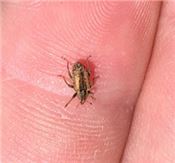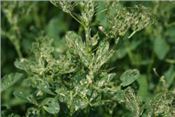Alfalfa Weevils – Now What?
DR. LEE TOWNSEND
LEXINGTON, KY.
The 2017 alfalfa weevil population is winding down, but some are taking their last bites before leaving fields. The few late-developing larvae, along with newly emerged adults, can feed on stems, crowns, and shoots produced after harvest. Surviving larvae may feed on developing leaves and new adults can cause notch-like feeding holes that give foliage a feathery appearance (Figure 1). Watch harvested fields carefully for the normal green-up that indicates active re-growth is underway. An insecticide application may be justified if adult weevils are found feeding on 50 percent or more of the crowns and re-growth is prevented for 3 to 6 days. Use low label rates if treatment is necessary.
Newly emerged alfalfa weevils (Figure 2) leave fields and enter a summer dormancy. They tend to settle outside but within a few feet of field edges, accumulating under surface litter or slightly below the soil surface. The insects will beat the heat by remaining there until about mid-October when they return to alfalfa. ∆
DR. LEE TOWNSEND: Extension Entomologist, University of Kentucky

Figure 2. Newly emerged alfalfa weevil adult is about ¼ inch long with a wide dark stripe down the
center of its back.
Photo: K. Wilson, Bourbon County Extension agent

Figure 1. Notch-like feeding holes from adult alfalfa weevils give leaves a feathery appearance.
Photo: Lee Townsend